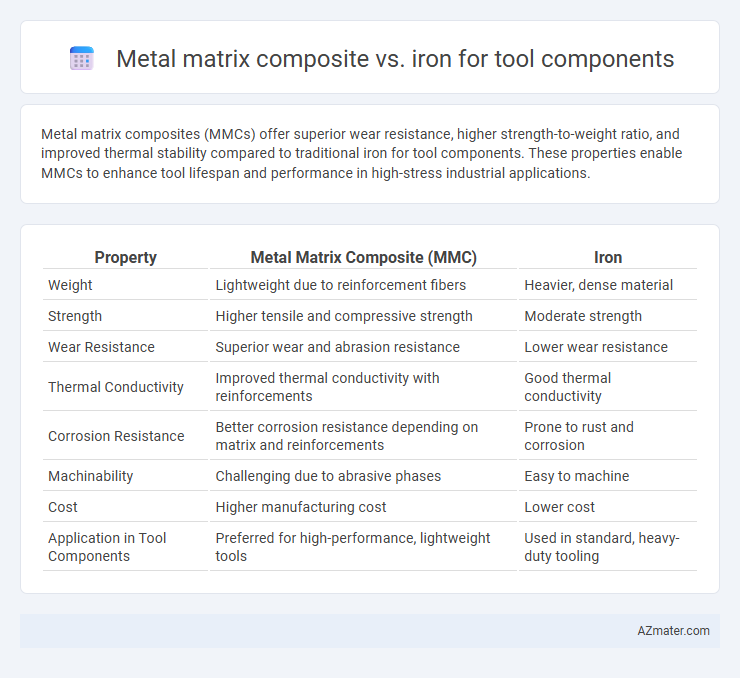Metal matrix composites (MMCs) offer superior wear resistance, higher strength-to-weight ratio, and improved thermal stability compared to traditional iron for tool components. These properties enable MMCs to enhance tool lifespan and performance in high-stress industrial applications.
Table of Comparison
| Property | Metal Matrix Composite (MMC) | Iron |
|---|---|---|
| Weight | Lightweight due to reinforcement fibers | Heavier, dense material |
| Strength | Higher tensile and compressive strength | Moderate strength |
| Wear Resistance | Superior wear and abrasion resistance | Lower wear resistance |
| Thermal Conductivity | Improved thermal conductivity with reinforcements | Good thermal conductivity |
| Corrosion Resistance | Better corrosion resistance depending on matrix and reinforcements | Prone to rust and corrosion |
| Machinability | Challenging due to abrasive phases | Easy to machine |
| Cost | Higher manufacturing cost | Lower cost |
| Application in Tool Components | Preferred for high-performance, lightweight tools | Used in standard, heavy-duty tooling |
Introduction to Tool Materials
Metal matrix composites (MMCs) offer superior wear resistance, high strength-to-weight ratio, and thermal stability compared to traditional iron alloys used in tool components. Iron-based materials, such as cast iron and tool steel, provide excellent toughness and machinability but often suffer from lower hardness and corrosion resistance. The choice between MMCs and iron for tool materials depends on the specific application demands, including load conditions, temperature exposure, and desired tool lifespan.
Overview of Metal Matrix Composites
Metal matrix composites (MMCs) combine metal alloys with ceramic reinforcements, offering superior strength-to-weight ratios and enhanced wear resistance compared to traditional iron-based tool components. MMCs exhibit improved thermal stability and corrosion resistance, making them ideal for high-performance tool applications requiring durability under extreme conditions. These composites enable tailored mechanical properties through controlled reinforcement distribution, surpassing the limitations of conventional iron tools in both efficiency and longevity.
Properties of Iron in Tool Components
Iron in tool components offers high hardness and excellent wear resistance, essential for maintaining cutting edge durability and performance under heavy loads. Its superior thermal conductivity helps dissipate heat efficiently during machining, reducing thermal deformation and extending tool life. The material's toughness and ability to absorb impact make iron suitable for tools subjected to shock and cyclic stresses, ensuring reliability in demanding industrial applications.
Strength and Durability Comparison
Metal matrix composites (MMCs) offer superior strength-to-weight ratios compared to traditional iron, enabling tool components to withstand higher mechanical stresses without deformation. The enhanced durability of MMCs results from their improved wear resistance and thermal stability, which significantly extends tool life under high-friction and high-temperature conditions. Iron, while cost-effective and easier to manufacture, generally exhibits lower fatigue resistance and is more prone to corrosion, reducing its long-term performance in demanding tool applications.
Wear Resistance: MMCs vs Iron
Metal matrix composites (MMCs) exhibit significantly higher wear resistance compared to traditional iron used in tool components, due to their reinforced ceramic particles that enhance hardness and reduce abrasion. The dispersion of materials like silicon carbide or alumina in MMCs increases their durability under high-stress, high-temperature conditions commonly encountered in machining and cutting operations. In contrast, iron components, particularly cast iron, tend to wear faster because of their lower hardness and susceptibility to microstructural fatigue.
Thermal Conductivity and Stability
Metal matrix composites (MMCs) exhibit significantly higher thermal conductivity compared to iron, enabling more efficient heat dissipation in tool components during high-temperature operations. MMCs maintain superior thermal stability under extreme thermal cycles, reducing deformation and wear, which prolongs tool life in demanding manufacturing environments. Iron, while durable, has lower thermal conductivity and is more prone to phase changes under thermal stress, leading to reduced performance in high-heat applications.
Corrosion Resistance Evaluation
Metal matrix composites (MMCs) offer superior corrosion resistance compared to traditional iron-based tool components due to their reinforced ceramic particles and alloying elements that form stable passive films. Iron tools often suffer from rapid oxidation and pitting in aggressive environments, reducing their service life significantly. Electrochemical tests and salt spray evaluations consistently demonstrate MMCs' enhanced durability and lower corrosion rates, making them ideal for tool applications exposed to harsh conditions.
Manufacturing and Cost Considerations
Metal matrix composites (MMCs) offer superior wear resistance and thermal stability compared to iron, enhancing tool component durability in high-stress manufacturing environments. The manufacturing process of MMCs involves complex powder metallurgy or casting techniques, which typically incur higher initial costs and require specialized equipment compared to conventional iron processes. Despite elevated upfront expenses, MMCs can reduce long-term tool replacement frequencies and maintenance costs, providing economic benefits in high-performance applications.
Application Suitability and Performance
Metal matrix composites (MMCs) offer superior wear resistance, higher strength-to-weight ratios, and better thermal conductivity compared to iron, making them ideal for high-performance tool components subjected to intense mechanical stress and elevated temperatures. Iron, particularly cast iron, provides excellent machinability and cost-effectiveness but lacks the fatigue resistance and stiffness required for precision tools in advanced manufacturing. Application suitability favors MMCs in aerospace, automotive, and cutting tools where durability and performance are critical, while iron remains prevalent in general-purpose tools and heavy-duty fixtures.
Future Trends in Tool Material Selection
Metal matrix composites (MMCs) offer superior wear resistance, higher strength-to-weight ratio, and enhanced thermal stability compared to traditional iron-based tool components, making them increasingly favored for future applications in high-performance tooling. Advancements in nanotechnology and additive manufacturing are accelerating the development of MMCs with tailored microstructures, optimizing tool life and cutting efficiency under extreme conditions. Demand for sustainable and lightweight materials drives ongoing research toward MMCs with recyclable matrices and improved corrosion resistance, positioning them as key materials in the next generation of tool component design.

Infographic: Metal matrix composite vs Iron for Tool component
 azmater.com
azmater.com